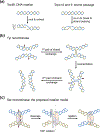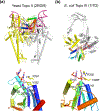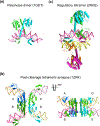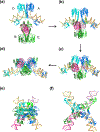Topoisomerases and site-specific recombinases: similarities in structure and mechanism
- PMID: 21087076
- PMCID: PMC6290911
- DOI: 10.3109/10409238.2010.513375
Topoisomerases and site-specific recombinases: similarities in structure and mechanism
Abstract
The processes of DNA topoisomerization and site-specific recombination are fundamentally similar: DNA cleavage by forming a phospho-protein covalent linkage, DNA topological rearrangement, and DNA ligation coupled with protein regeneration. Type IB DNA topoisomerases are structurally and mechanistically homologous to tyrosine recombinases. Both enzymes nick DNA double helices independent of metal ions, form 3'-phosphotyrosine intermediates, and rearrange the free 5' ends relative to the uncut strands by swiveling. In contrast, serine recombinases generate 5'-phospho-serine intermediates. A 180° relative rotation of the two halves of a 100 kDa terameric serine recombinase and DNA complex has been proposed as the mechanism of strand exchange. Here I propose an alternative mechanism. Interestingly, the catalytic domain of serine recombinases has structural similarity to the TOPRIM domain, conserved among all Type IA and Type II topoisomerases and responsible for metal binding and DNA cleavage. TOPRIM topoisomerases also cleave DNA to generate 5'-phosphate and 3'-OH groups. Based on the existing biochemical data and crystal structures of topoisomerase II and serine recombinases bound to pre- and post-cleavage DNA, I suggest a strand passage mechanism for DNA recombination by serine recombinases. This mechanism is reminiscent of DNA topoisomerization and does not require subunit rotation.
Conflict of interest statement
Declaration of Interest
The research was funded by the intramural research program of NIDDK, NIH.
Declaration of no interest
The author reports no conflicts of interest. The author alone is responsible for the content and writing of the paper.
Figures








Similar articles
-
DNA manipulators: caught in the act.Curr Opin Struct Biol. 2003 Feb;13(1):15-22. doi: 10.1016/s0959-440x(02)00006-4. Curr Opin Struct Biol. 2003. PMID: 12581655 Review.
-
A newly identified, essential catalytic residue in a critical secondary structure element in the integrase family of site-specific recombinases is conserved in a similar element in eucaryotic type IB topoisomerases.J Mol Biol. 1999 Jun 11;289(3):517-27. doi: 10.1006/jmbi.1999.2793. J Mol Biol. 1999. PMID: 10356326
-
Architecture of the hin synaptic complex during recombination: the recombinase subunits translocate with the DNA strands.Cell. 2004 Oct 1;119(1):33-45. doi: 10.1016/j.cell.2004.09.010. Cell. 2004. PMID: 15454079
-
Direct observation of subunit rotation during DNA strand exchange by serine recombinases.Nat Commun. 2024 Nov 29;15(1):10407. doi: 10.1038/s41467-024-54531-4. Nat Commun. 2024. PMID: 39613732 Free PMC article.
-
Vaccinia virus DNA topoisomerase: a model eukaryotic type IB enzyme.Biochim Biophys Acta. 1998 Oct 1;1400(1-3):321-37. doi: 10.1016/s0167-4781(98)00144-4. Biochim Biophys Acta. 1998. PMID: 9748643 Review.
Cited by
-
Serine Resolvases.Microbiol Spectr. 2015 Apr;3(2):MDNA3-0045-2014. doi: 10.1128/microbiolspec.MDNA3-0045-2014. Microbiol Spectr. 2015. PMID: 26104713 Free PMC article. Review.
-
An algebraic view of bacterial genome evolution.J Math Biol. 2014 Dec;69(6-7):1693-718. doi: 10.1007/s00285-013-0747-6. Epub 2013 Dec 29. J Math Biol. 2014. PMID: 24375264
-
Structures of B. subtilis Maturation RNases Captured on 50S Ribosome with Pre-rRNAs.Mol Cell. 2020 Oct 15;80(2):227-236.e5. doi: 10.1016/j.molcel.2020.09.008. Epub 2020 Sep 28. Mol Cell. 2020. PMID: 32991829 Free PMC article.
-
Structural characterization of Class 2 OLD family nucleases supports a two-metal catalysis mechanism for cleavage.Nucleic Acids Res. 2019 Sep 26;47(17):9448-9463. doi: 10.1093/nar/gkz703. Nucleic Acids Res. 2019. PMID: 31400118 Free PMC article.
-
The topoisomerase 3α zinc-finger domain T1 of Arabidopsis thaliana is required for targeting the enzyme activity to Holliday junction-like DNA repair intermediates.PLoS Genet. 2018 Sep 17;14(9):e1007674. doi: 10.1371/journal.pgen.1007674. eCollection 2018 Sep. PLoS Genet. 2018. PMID: 30222730 Free PMC article.
References
Publication types
MeSH terms
Substances
Grants and funding
LinkOut - more resources
Full Text Sources
Research Materials
